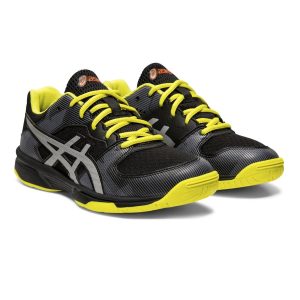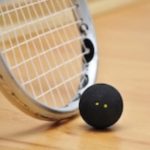When it comes to finding the best squash shoes for junior players, there are a few factors to consider, such as comfort, support, durability, and traction.

Asics Gel Tactic Junior (image credit: Just Squash)
In our previous blog on why Squash shoe comfort matters, it is equally as important for junior players to wear squash shoes that fit well and offer support for the ankle and provide stability for lunging and lateral movement, helping you minimise the risk of injury to your child whilst they are playing.
Leading squash shoes on the market
Following research and reviews, here are a few junior Squash shoes on the market, which are well-regarded by both junior players and coaches:
- Asics Gel-Rocket 9: considered a popular choice for junior players, it offers both good cushioning and stability, along with a durable rubber sole that provides excellent grip on the court.
- Salming Adder Junior: designed specifically for junior players and has a lightweight, breathable design with a low profile for a better court feel. The shoe also features Salming’s patented RollBar technology for added stability and support.
- Adidas Courtjam Bounce: known for its comfort and durability, with a flexible Bounce midsole that provides good cushioning and a rubber outsole for solid traction on the court.
- Yonex Power Cushion Eclipsion Junior: a great option for junior players who need extra support and stability, with Yonex’s Power Cushion technology that absorbs shock and a durable rubber outsole for better traction.
So which one, would we recommend? Well, recently one of our associates purchased Squash shoes for their nephew and selected the Yonex Power Cushion Eclipsion Junior – as according to online reviews it is value for money, along with popularity, amongst junior squash players, also Yonex is a brand of choice when it comes to other racquet sports.
Rules on shoe replacement
When it comes to replacing your child’s Squash shoes, the general rule is that junior squash players should replace their shoes whenever they begin to show signs of significant wear and tear, or when they no longer provide adequate support and cushioning for the player’s feet.
The frequency of shoe replacement will depend on a variety of factors, such as the frequency and intensity of play, the type of court surface, and the quality of the shoes. As a general rule of thumb, junior squash players who play regularly should consider replacing their shoes every 6-12 months.
Some signs that it may be time to replace squash shoes include worn-out soles, holes or tears in the upper part of the shoe and loss of cushioning or support. If a junior squash player experiences foot pain or discomfort during or after playing, it may also be a sign that their shoes are no longer providing adequate support and should be replaced.
Understanding the importance of outsole/insole
Just like elite senior players, it is important for parents to know the importance of both outsole and insole when purchasing a new pair of junior Squash shoes.
The quality of outsoles is important as the last thing you need is for your kid to slip while playing the game. In order to prevent this can be avoided by selecting squash shoes which feature high-quality outsoles that provide an excellent grip.
If your child plays at a high-end Squash club, there is usually a rule in the manifesto that permits members not to wear shoes that leave markings on their courts. Buy shoes with a sole that doesn’t leave any marks on the court so that your child doesn’t get into trouble.
Removable Insoles, one suggestion is to opt for a pair that has removable insoles. This way you can replace the soles with medical orthotics where necessary for even greater shock absorption.
Both the outsole and insole of junior squash shoes are essential for the overall performance and comfort of the player.
The outsole is the bottom part of the shoe that comes into contact with the court surface. It is crucial that the outsole provides excellent grip and traction to prevent slipping and sliding on the court.
The outsole should also be durable enough to withstand the wear and tear that comes with playing squash regularly. Additionally, some outsoles are designed to offer specific features like extra cushioning, stability, or flexibility to enhance the player’s performance.
On the other hand, the insole is part of the shoe that is in contact with the player’s foot.
A good insole should provide cushioning and support to the foot, ensuring the player’s comfort throughout the game. The insole should also be breathable to keep the player’s foot dry and cool, as well as flexible to allow for ease of movement on the court.
For junior squash players, the outsole and insole are especially important as they are still growing and developing. A shoe with a good outsole and insole will provide the necessary support and protection for their feet, which can prevent injuries and promote proper foot development.
Final Thoughts
In conclusion, ultimately when purchasing, the best squash shoe for a junior player will depend on their individual needs and preferences, as well as their level of play.
Also, it’s important to try on different shoes and find the one that feels most comfortable and supportive for your child’s Squash game; furthermore, as they progress in the sport they could land a major shoe deal with a high-profile Squash equipment brand, thus they will credit you for helping that choice.





